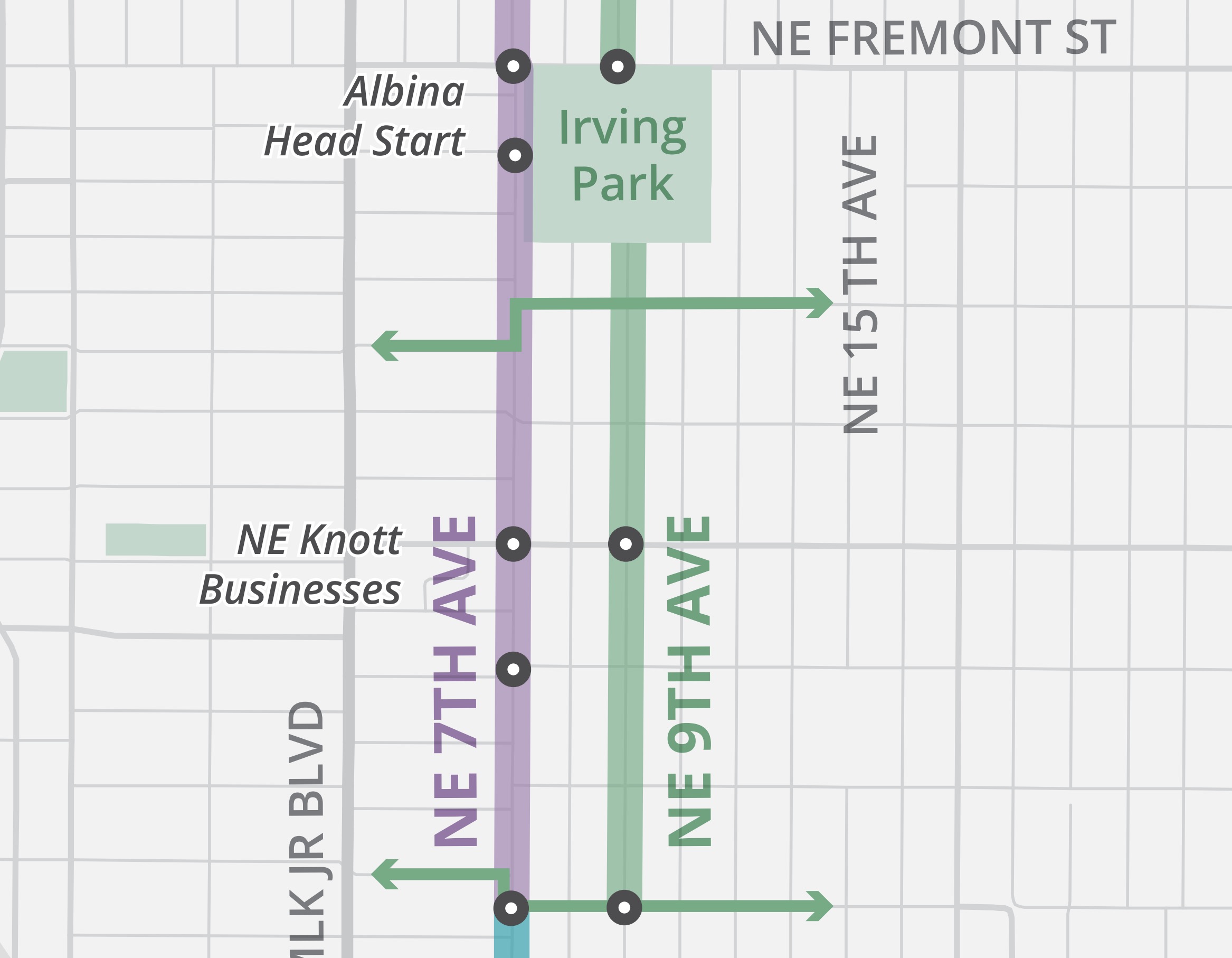
Close-up of new proposal showing where the greenway will jog over to 9th. See full map below.
(Graphic: City of Portland)
The Portland Bureau of Transportation has shifted course on their Lloyd to Woodlawn Neighborhood Greenway project. Citing a lack of “broad community support,” for the Northeast 7th Avenue route option, they’ll announce later today that the new greenway will be on Northeast 9th Avenue.
The change in plans comes despite major support and a grassroots activism effort to save the 7th Avenue route.
Background
When it was announced one year ago, PBOT said the final route could be either 7th or 9th, or a combination of the two; but initial public feedback strongly favored 7th. 7th is the flattest and most direct route between the forthcoming Sullivan’s Crossing Bridge over I-84 and the Woodlawn neighborhood, while 9th has hills and other considerable drawbacks from a planning, budget, and connectivity perspective.
9th also runs squarely into Irving Park, which does not currently have a through bikeway that meets greenway standards.
Once plans for the 7th Avenue route came into focus back in July, those who supported it were even more excited. PBOT’s plans were truly groundbreaking and represented an unprecedented level of human-scale, cycling-oriented designs. There were mini-roundabouts, a park that would stretch across the street (creating to cul-de-sacs that would create dead-ends for drivers), and more.
But there was one big problem: A key segment of the community — one that has weathered institutional discrimination and vast changes to their neighborhoods in a relatively short period of time — was not fully on board.
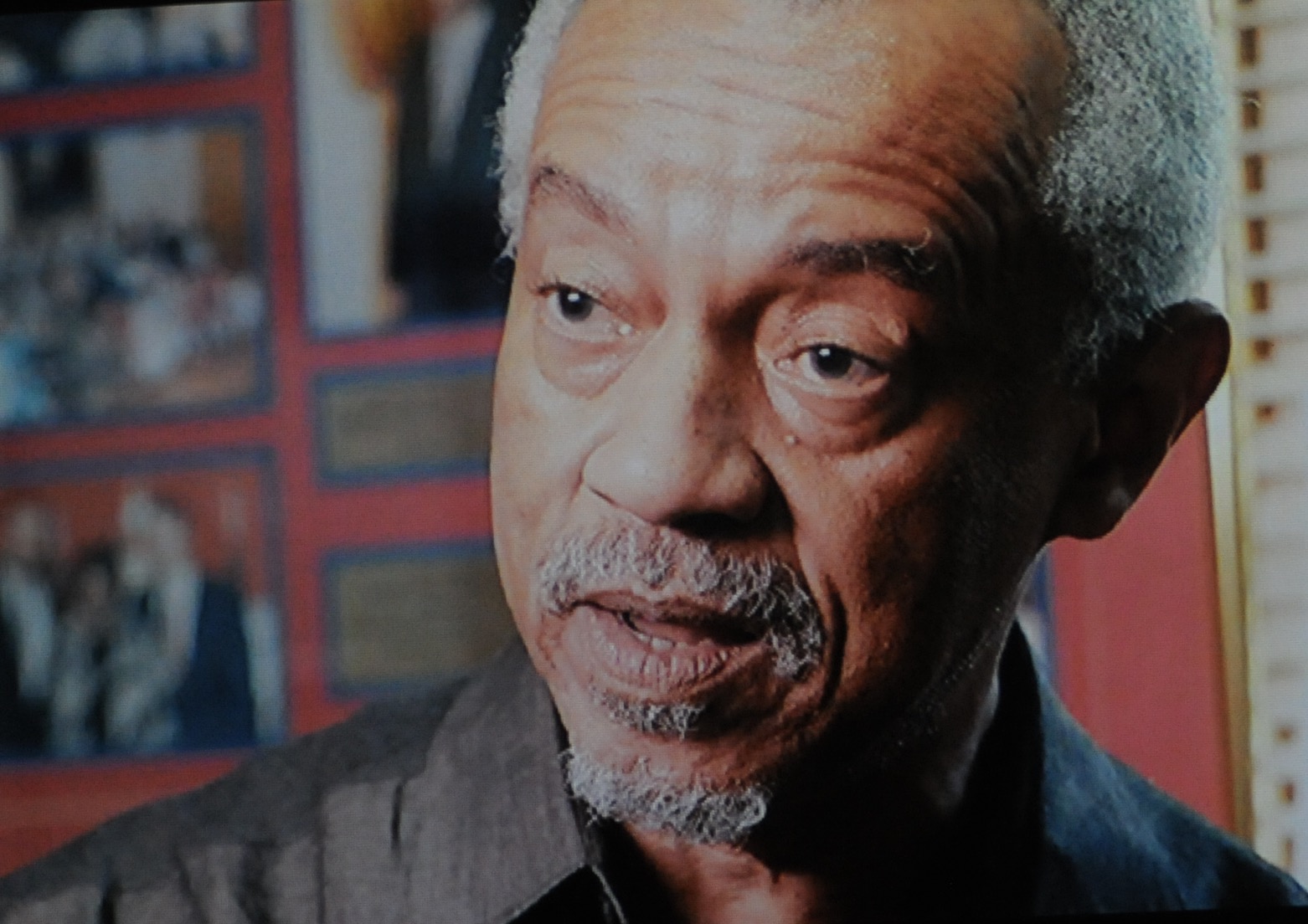

“This would make it more difficult for people — frankly, low-income people who are trying to use the services of Head Start.”
— Ron Herndon, Albina Head Start to The Skanner in August 2018
Many black people who’ve lived in adjacent neighborhoods for a half-century or more were not comfortable with such transformative changes to 7th Avenue. The backlash to the project reminded us of the controversy in 2011 around the North Williams Avenue project. People like Albina Head Start Executive Director Ron Herndon (shown above), were concerned about how the plans would impact driving access to his building on the corner of 7th and Northeast Fremont. And Herndon wasn’t the only one.
PBOT soon came to the realization that their traditional methods of engagement and open houses were not giving them a complete picture of public opinion. So in September of last year they paused the project and took it directly to black business owners, black residents and black community leaders.
PBOT’s realization and rationale
“There’s no doubt we underestimated the role that this street plays in the hearts and minds of Portland’s black community.”
— Nick Falbo, PBOT project manager
PBOT Project Manager Nick Falbo said in a phone interview last week that despite their attempts to include all community voices in the planning process, “There’s no doubt we underestimated the role that this street plays in the hearts and minds of Portland’s black community.”
Falbo said they worked hard to make sure their initial plan for a 7th Avenue greenway accommodated all the needs of business owners and other stakeholders along the corridor. They presented it to neighborhood associations and organizations like Head Start and the Soul District Business Association. At the same time, letters of support for 7th Avenue were pouring in.
“But it got the point,” Falbo shared, “Where that support [for 7th] was actually becoming a liability.”
As support grew with the realization that a dream-like cycling street could become a reality, so did the opposition.
“We started hearing from the Soul District Business Association and other black community partners like SEI [Self Enhancement, Inc.] and PCRI [Portland Community Reinvestment Initiatives] and they started raising concerns,” Falbo said. “When Albina Head Start says this might be bad for their families, and when John Washington with Soul District Business Association says this might be bad for their main street, and when service providers in the area say this will be bad for their communities, we really owe it to them to listen.”
Falbo said PBOT realized there was a “big division” in the community. So they held two focus groups in December and January organized by SEI and PCRI. “We learned a lot,” Falbo said. When it comes to 7th Avenue, “It certainly plays a bigger role in the black community than we ever anticipated.”
According to a fact sheet on the focus groups published today, one participant said, “We know change will happen; that’s life. But the change has to be tailored to the community, not just an individual group without regard for others.” Another person said, “As soon as an idea comes up for any kind of project or changes, Black folks need to be at the table. Sometimes, we don’t even know there’s a table to be at!”
BikePortland relies on financial support from readers like you.
Please join hundreds of other readers and
subscribe for $10/month or
make a one-time payment today!
Falbo said a major takeaway from these focus groups was a realization that PBOT’s Bicycle Plan for 2030 — passed in 2010, before the Williams project and the racial reckoning at PBOT that came with it — is woefully outdated when it comes to the issue of racial equity. “What we heard from our black community partners was that they weren’t involved in those processes [the Bike Plan and Transportation System Plan] and when we come to the community and we say, ‘Hey we’ve got these greenways for 7th and 9th,’ a lot of the response is, ‘Where did those [ideas] even come from?'”
And, similar to feelings we heard expressed around the Williams project, there’s a legacy of distrust around change in these neighborhoods — especially when it’s proposed by a government agency and isn’t seen as a benefit to long-time residents. “What they see in a project like this,” Falbo explained, “Is transformative change with the opportunity for unintended consequences and it’s something they fail to see a lot of value in. They’re just not getting things from this project that some others might be.”
Keep in mind, the changes proposed for 7th weren’t just a new bike lane. They would have forever altered the street, and therefore, the neighborhood.
As Falbo put it: “After more communication with these community partners it was pretty clear that we lacked the broad support that would be necessary for transformative change on 7th.”
The proposal
Instead of a greenway on 7th, PBOT will put it on 9th. They’ll also create what they call a “Safer 7th”. They say it’s a “double-win”. Instead of changes to just one corridor, we’ll get changes on two.
On 7th, the focus will no longer be to reduce the number of drivers. PBOT will instead use speed bumps and other measures to slow traffic down and improve safety. “Everything but diversion,” is how Falbo described it.
The existing traffic circle at 7th and Tillamook will be removed, and they might remove several others as well. Falbo says the circles work well on lower-volume streets, but as competition for space increases, they become points of conflict.
PBOT will create new crossings near schools, businesses, and at the bike streets of Tillamook, Morris, and Going. There will also be a new bike lane between Tillamook and Weidler to help people connect to the Lloyd District and the Sullivan’s Crossing Bridge.
The new greenway on 9th will begin at Tillamook and go north to Holman (another greenway). There will be median island diverters to aid in crossing and reduce driving volumes at the intersections with Webster and Emerson, as well as Ainsworth. PBOT will beef up crossings at Tillamook, Fremont, Prescott, Alberta and Killingsworth.
As for how to get through Irving Park, PBOT says they’re still working with Portland Parks & Recreation to figure out a design and funding. The plan will be to go ahead with construction of the greenway project without the new path through park. “We recognize the Irving Park path today is inadequate for bicycling, but we are committed to trying to solve that problem,” is how Falbo put it.
Responses to the new proposal
With the compromise on 7th and the greenway on 9th, PBOT says this new proposal has the broad support they didn’t see when the project focused solely on 7th.

New 7th Avenue resident Kiel Johnson (here with his daughter Lulu) is disappointed by the decision.
(Photo: Kiel Johnson)
PBOT Capital Projects, Assets and Maintenance Communications Coordinator Hannah Schafer says the new proposal gives the community even more. “We’re making improvements on two separate streets… From our perspective this additional engagement we did with the black community helped us build a better project.”
For Falbo, the experience has been a major education. “It definitely pointed to some blindspots,” he said.
Given what happened on Williams Avenue, how did PBOT not see this coming? When I asked Falbo that question, he said they knew they were operating, “in the shadow of Williams,” and that the blindspots with this project were partly based on timing (Williams was eight years ago). “There are different stakeholders now… Many people come and go, and roles change, and we haven’t done the best job maintaining those relationships from that experience. So we had to rebuild those relationships.”
“We hope this decision will in some small way demonstrate this community values the participation of people of color in public investment decisions.”
— Jillian Detweiler, The Street Trust
New 7th Avenue resident Kiel Johnson is an active community volunteer who owns the Go By Bike valet and bike shop in the South Waterfront District and is a regular contributor to BikePortland. He launched a grassroots effort in support of 7th Avenue that we chronicled in a series of articles. He’s disappointed with the outcome (in a meeting this week with PBOT’s Falbo, he walked out of the room upon hearing the news). “Sometimes you get the outcome you want, and sometimes you do not,” he shared with us via email yesterday. “The dream of a calm street outside our door where our children could safely go outside had come to represent something more than just an infrastructure project.”
Johnson met many of his neighbors during his work. Those new bonds won’t go away even if his dream for 7th Avenue has. “We may not get the greenway we wanted,” he said, “but we can still make a better community and in the end that is what this is all about.”
The Street Trust supports PBOT’s decision to put the greenway on 9th. In a statement, Executive Director Jillian Detweiler said, “We hope this decision will in some small way demonstrate this community values the participation of people of color in public investment decisions. A project on NE 9th can deliver the low-car experience needed to make a variety of cyclists feel comfortable without disrupting access to institutions serving people of color. The Street Trust is eager to advocate to complete the greenway through Irving Park to create a memorable route marked by a beautiful off-street segment.”
The project is scheduled for construction in 2020. Stay tuned for announcements of open houses and other opportunities to weigh in on the new proposal to iron out design details.
Learn more at PBOT’s Lloyd to Woodlawn Neighborhood Greenway project page.
— Jonathan Maus: (503) 706-8804, @jonathan_maus on Twitter and jonathan@bikeportland.org
Never miss a story. Sign-up for the daily BP Headlines email.
BikePortland needs your support.
The post PBOT decides on 9th Avenue for route of future Lloyd to Woodlawn Neighborhood Greenway appeared first on BikePortland.org.
from Latest headlines from BikePortland https://ift.tt/2unVmRS

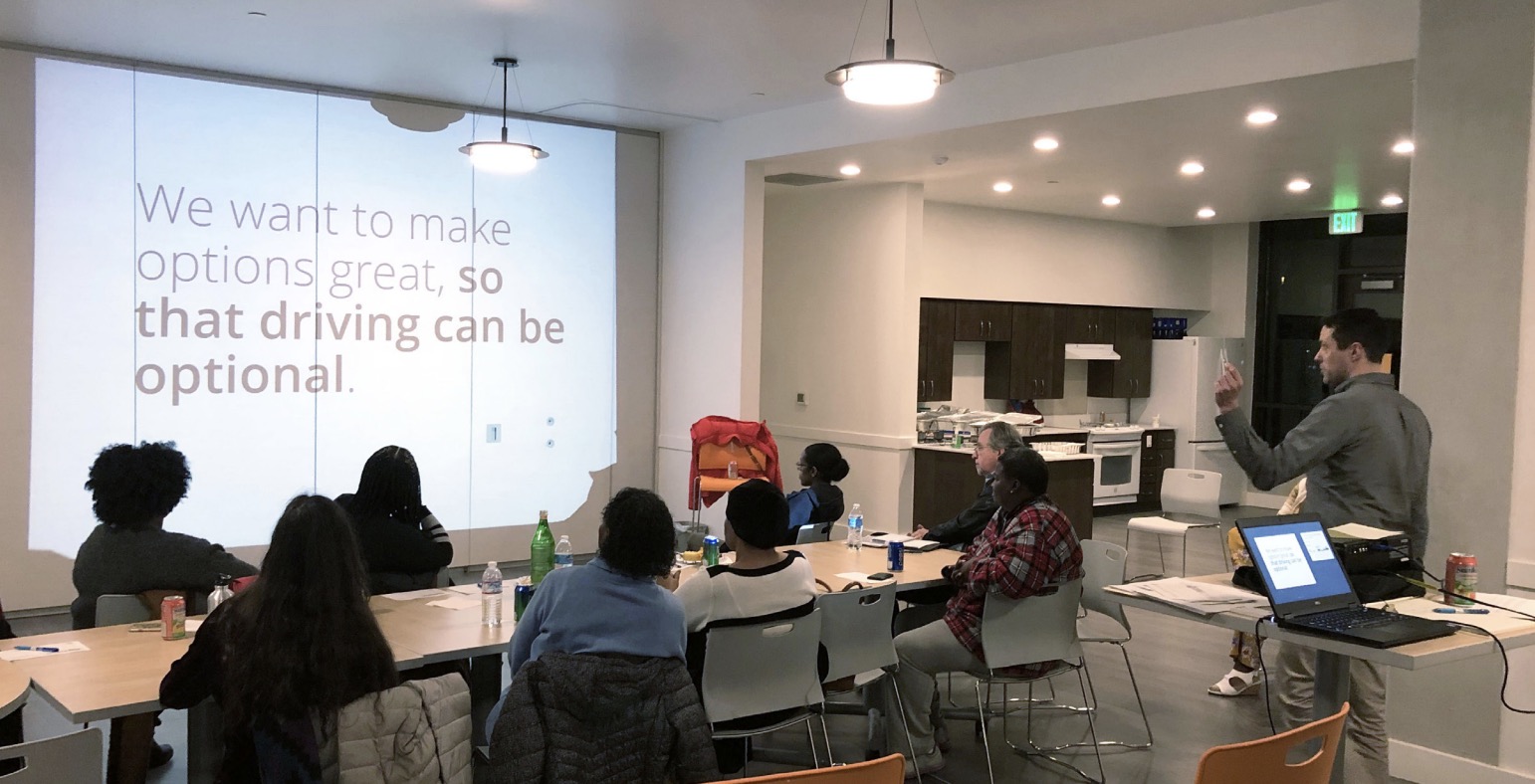


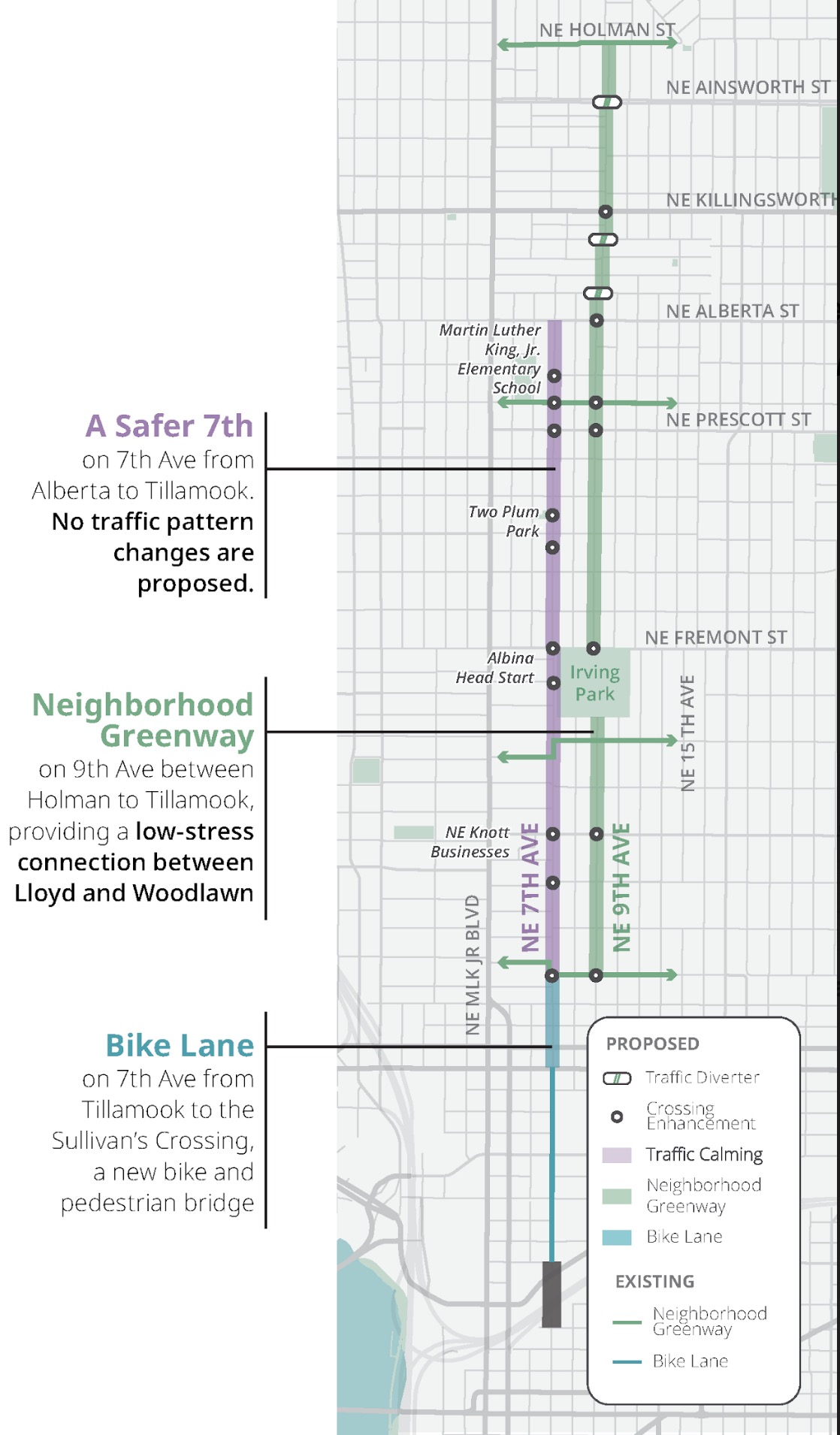
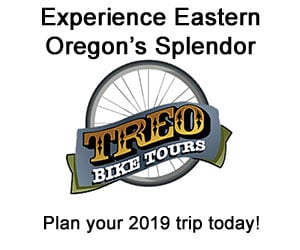
No comments:
Post a Comment